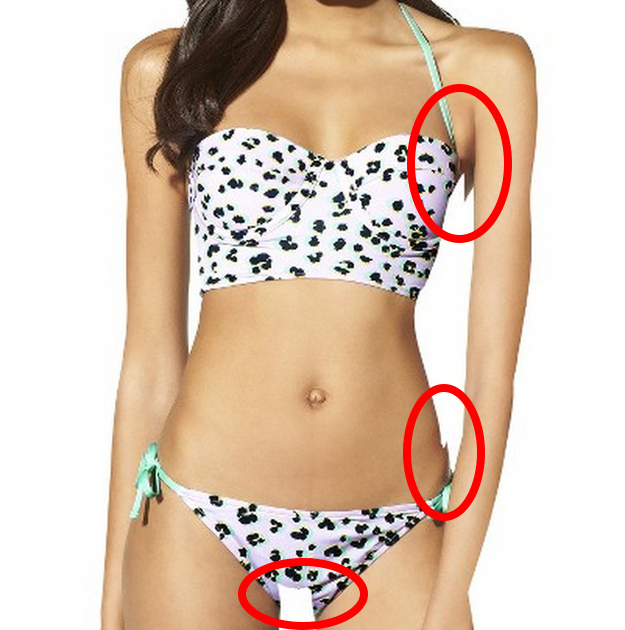
Related Class
Photoshop debacle haunts Target's reputation
- Published on

The Internet has been swept with another rash of criticisms over a Photoshop debacle, and this time, the culprit was Target, a company that typically fares well in the design department. Although the photos have been taken down from the corporation's website, news of the mistakes - which were quite blatant - linger on, perpetuated across popular tabloid-esque media outlets, such as Buzzfeed and Jezebel.
While the damage is done, and likely irreversible because of the speed with which highly public incidents like this germinate across the Web, there are definitely lessons to be learned. Despite the affects this might have on Target's reputation, the response that this inelegant editing received serves as a reminder that the public is certainly cognizant of the role that good, viable Photoshop skills mean in an industry that makes a majority of its money through the use of images.
What went wrong?
According to Jezebel, there are multiple issues with this design flaw. The image, which features a slender young woman, who appears to be in her late teens, is modeling this season's junior swimsuit line by Xhilaration. Before consumers roll over the picture and zoom in to get a closer look, nothing appears out of the ordinary. The model is smiling, the swimsuit looks just fine and, although her arm looks slightly distended, it isn't something that would be obvious at a quick glance.
However, when the image is zoomed in, there are clearly areas where the designer seemed to be in a hurry. First, the arm that looked a little stretched from far away has obviously been trimmed down. No matter the tool that was used, whether a hastily added white shape or a sloppy erase job, leftover jagged edges and what looks like a narrowing of the hips and bicep outshine the intended focus of the image - the swimsuit itself.
The mistakes continue as your eyes travel to the bottom. While the model's thighs seemed normal in the zoomed-out version, the same is not true if you hoped to get a better impression of the way the bathing suit hugged the lower half of the figure. A visibly added square shape has been cropped into the image between the young lady's legs, in a possible attempt to widen the gap between her thighs to comport to the popular opinion of what a slender female body looks like.
What are the far-reaching implications?
According to Web Pro News, the Target snafu calls the broader question of young girls' self-esteem and body image issues into focus. As this mistake was featured in an area of Target's website that markets primarily to young women, the idea that the designers were slimming down body parts on a model who is already quite thin is what sent this news viral.
From a designer's perspective, this is nothing new. The fashion industry's opinion about what an appealing woman looks like is not typically a battle that you can fight when you're on a deadline and have several photos to edit, but because of these sloppy mistakes, Target must now answer to the scores of consumers who are outraged by this marketing technique. Instead of increasing the company's sales, its reputation is under fire, and it's the direct result of this one image. Although the individuals who first noticed the mistake are likely not Photoshop experts themselves, you do not necessarily need to understand how the software works to recognize these errors.
How could this have been prevented?
Although these mistakes are easy to spot, sometimes a little extra training with the design elements that go into perfecting an image like this one can reinforce the skills you'll need to successfully render images in such a high-stakes environment. If you're considering a career in this field, the American Graphics Institute provides Photoshop classes that can help you build the expertise to help you avoid making similar errors, and teach you how to make images look great, without the need for sculpting and excessive manipulation.

About the author
Jennifer Smith is a user experience designer, educator and author based in Boston. She has worked in the field of user experience design for more than 15 years.She has designed websites, ecommerce sites, apps, and embedded systems. Jennifer designs solutions for mobile, desktop, and iOT devices.
Jennifer delivers UX training and UX consulting for large Fortune 100 companies, small start-ups, and independent software vendors.She has served as a Designer in Residence at Microsoft, assisting third-party app developers to improve their design solutions and create successful user experiences. She has been hired by Adobe and Microsoft to deliver training workshops to their staff, and has traveled to Asia, Europe, India, the Middle East, and across the U.S. to deliver courses and assist on UX design projects. She has extensive knowledge of modern UX Design, and worked closely with major tech companies to create educational material and deliver UX workshops to key partners globally. Jennifer works with a wide range of prototyping tools including XD, Sketch, Balsamiq, Fireworks, Photoshop, Illustrator, and Blend for Visual Studio. She also works extensively in the fields of presentation design and visual design.
Jennifer is also an expert on Photoshop, digital image editing, and photo manipulation. Having written 10 books on Photoshop, and having consulted and provided training to major media companies and businesses around the globe.
Jennifer is the author of more than 20 books on design tools and processes, including Adobe Creative Cloud for Dummies, Adobe Creative Cloud Digital Classroom, and Photoshop Digital Classroom. She has been awarded a Microsoft MVP three times for her work with user experience design in creating apps for touch, desktop, and mobile devices. Jennifer holds the CPUX-F certification from the User Experience Qualification Board and assists others in attaining this designation in leading a UX certification course at American Graphics Institute. She is a candidate for a Master’s degree in Human Factors in Information Design.


